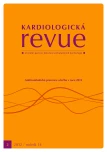New antithrombotic drugs in the prophylaxis of postoperative venous thromboembolism
Authors:
P. Kessler
Authors‘ workplace:
Odd. hematologie a transfuziologie, Nemocnice Pelhřimov, p. o.
Published in:
Kardiol Rev Int Med 2012, 14(2): 93-96
Overview
The risk of postoperative venous thromboembolism is substantial, especially in patients undergoing major orthopedic surgery. Low molecular weight heparins have been established as “gold standard” of pharmacological thromboprophylaxis in this group of patients; however, the subcutaneous administration is inconvenient, the effectiveness is dependent on antithrombin level, and they are contraindicated in some cases such as allergy or heparin induced thrombocytopenia. Three new oral anticoagulants have recently been approved for thromboprophylaxis after hip and knee athroplasty – an oral direct thrombin inhibitor dabigatran and two oral direct inhibitors of activated factor X (rivaroxaban and apixaban). Their major benefits are the oral route of administration, relatively wide therapeutic window, and predictable pharmacokinetics. Their major disadvantages are: lack of antidote and contraindication in patients with impairment of renal function (Dabigatran is contraindicated in patients with glomerular filtration < 30 ml/min., rivaroxaban and apixaban are contraindicated in patients with glomerular filtration < 15 ml/min.). The pharmacokinetics of these antithrombotic drugs leads to a low risk of drug interactions; they are limited to P-glycoprotein inhibitors and inducers, which influence the level of dabigatran, drugs inhibiting both P-glycoprotein and CyP 3A4, which increase rivaroxaban and apixaban exposure, and inducers of P-glycoprotein and/or CyP 3A4, which induce reduction of rivaroxaban and apixaban level.
Keywords:
dabigatran – rivaroxaban – apixaban – thromboprophylaxis – hip replacement – knee replacement
Sources
1. Spahn DR, Rossaint R. Coagulopathy and blood component transfusion in trauma. Br J Anaesth 2005; 95 : 130–139.
2. Paparella D, Brister SJ, Buchanan MR. Coagulation disorders of cardiopulmonary bypass: a review. Intensive Care Med 2004; 30 : 1873–1881.
3. Grant PJ, Tate GM, Davies JA et al. Intra-operative activation of coagulation – a stimulus to thrombosis mediated by vasopressin? Thromb Haemost 1986; 55 : 104–107.
4. Geerts WH, Bergqvist D, Pineo GF et al. American College of Chest Physicians. Prevention of venous thromboembolism: American College of Chest Physicians Evidence-Based Clinical Practice Guidelines (8th Edition). Chest 2008; 133 (6 Suppl): 381S–453S.
5. Stangier J, Rathgen K, Stähle H et al. The pharmacokinetics, pharmacodynamics and tolerability of dabigatran etexilate, a new oral direct thrombin inhibitor, in healthy male subjects. Br J Clin Pharmacol 2007; 64 : 292–303.
6. Walenga JM, Adiguzel C. Drug and dietary interactions of the new and emerging oral anticoagulants. Int J Clin Pract 2010; 64 : 956–967.
7. Eriksson BI, Dahl OE, Rosencher N et al. RE-NOVATE Study Group. Dabigatran etexilate versus enoxaparin for prevention of venous thromboembolism after total hip replacement: a randomised, double-blind, non-inferiority trial. Lancet 2007; 370 : 949–956.
8. Eriksson BI, Dahl OE, Rosencher N et al. Oral dabigatran etexilate vs. subcutaneous enoxaparin for the prevention of venous thromboembolism after total knee replacement: the RE-MODEL randomized trial. J Thromb Haemost 2007; 5 : 2178–2185.
9. RE-MOBILIZE Writing Committee, Ginsberg JS, Davidson BL, Comp PC et al. Oral thrombin inhibitor dabigatran etexilate vs North American enoxaparin regimen for prevention of venous thromboembolism after knee arthroplasty surgery. J Arthroplasty 2009; 24 : 1–9.
10. Eriksson BI, Dahl OE, Huo MH et al. Oral dabigatran versus enoxaparin for thromboprophylaxis after primary total hip arthroplasty (RE-NOVATE II*). A randomised, double-blind, non-inferiority trial. Thromb Haemost 2011; 105 : 721–729.
11. Zhou W, Schwarting S, Illanes S et al. Hemostatic therapy in experimental intracerebral hemorrhage associated with the direct thrombin inhibitor dabigatran. Stroke 2011; 42 : 3594–3599.
12. Ganetsky M, Babu KM, Salhanick SD et al. Dabigatran: review of pharmacology and management of bleeding complications of this novel oral anticoagulant. J Med Toxicol 2011; 7 : 281–287.
13. Weinz C, Schwartz T, Pleiss U et al. Metabolism and distribution of [14C] BAY 59–7939 – an oral, direct Factor Xa inhibitor – in rat, dog and human. Drug Metab Rev 2004; 36: Abstract 196.
14. Eriksson BI, Borris LC, Friedman RJ et al. RECORD1 Study. Rivaroxaban versus enoxaparin for thromboprophylaxis after hip arthroplasty. N Engl J Med 2008; 358 : 2765–2775.
15. Lassen MR, Ageno W, Borris LC et al. RECORD3 Investigators. Rivaroxaban versus enoxaparin for thromboprophylaxis after total knee arthroplasty. N Engl J Med 2008; 358 : 2776–2786.
16. Turpie AG, Lassen MR, Davidson BL, et al. RECORD4 Investigators. Rivaroxaban versus enoxaparin for thromboprophylaxis after total knee arthroplasty (RECORD4): a randomised trial. Lancet 2009; 373 : 1673–1680.
17. Godier A, Miclot A, Le Bonniec B et al. Evaluation of prothrombin complex concentrate and recombinant activated factor VII to reverse rivaroxaban in a rabbit model. Anesthesiology 2012; 116 : 94–102.
18. He K, Luettgen JM, Zhang D et al. Preclinical pharmacokinetics and pharmacodynamics of apixaban, a potent and selective factor Xa inhibitor. Eur J Drug Metab Pharmacokinet 2011; 36 : 129–139.
19. Lassen MR, Raskob GE, Gallus A et al. Apixaban versus enoxaparin for thromboprophylaxis after knee replacement (ADVANCE-2): a randomised double--blind trial. Lancet 2010; 375 : 807–815.
20. Lassen MR, Gallus A, Raskob GE et al. ADVANCE-3 Investigators. Apixaban versus enoxaparin for thromboprophylaxis after hip replacement. N Engl J Med 2010; 363 : 2487–2498.
Labels
Paediatric cardiology Internal medicine Cardiac surgery CardiologyArticle was published in
Cardiology Review

2012 Issue 2
Most read in this issue
- Antiaggregating and anticoagulant therapy – basic principles
- Anticoagulant therapy and atrial fibrillation
- Where is a step in the current development of drugs that affect blood clotting?
- Current guidelines for antiplatelet therapy in neurology
